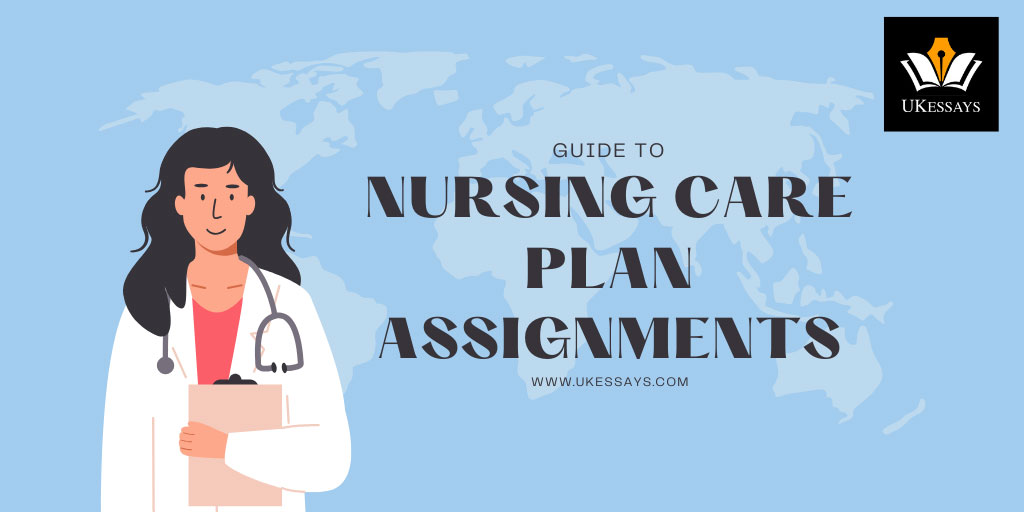Guide to nursing care plan assignments
Info: 3075 words (12 pages) Study Guides
Published: 07 Oct 2025

Get nursing assignment help from qualified nurses who understand real clinical practice. Achieve accurate, evidence-based care plans that meet academic standards. See our nursing assignment help page for info.
Writing a nursing care plan is a fundamental skill for nursing students and practitioners. Care plans serve as “roadmaps” for patient care, outlining assessment findings, identified needs, goals, and interventions. They facilitate standardised, evidence-based and holistic care (Ballantyne 2016).
In the UK, nurses are expected to use evidence-based knowledge and person-centred approaches when planning care (Royal College of Nursing 2023). Therefore, completing a care plan assignment is not just an academic exercise – it mirrors real-world nursing practice and upholds professional standards.
This guide provides a comprehensive, practical approach to writing effective nursing care plan assignments, including how to justify decisions with evidence-based rationale. Examples (such as a post-hip replacement scenario) are woven throughout to illustrate key points. By following a clear structure and grounding each care decision in evidence, student nurses can produce high-quality care plans that demonstrate clinical reasoning and promote better patient outcomes.
Understanding nursing care plans and their purpose
A nursing care plan is a written document that outlines an individualised plan of care for a patient, typically following the steps of the nursing process. The main focus of a care plan is to ensure care is holistic and evidence-based, addressing a patient’s physical, psychological, social, and even spiritual needs (Ballantyne 2016).
In practice, care plans are used by the multidisciplinary team to communicate patient needs, interventions, and progress. They help provide continuity of care between shifts and across settings.
For students, care plan assignments develop critical thinking by having them identify patient problems and plan nursing interventions systematically. Importantly, a care plan is also a form of professional documentation. It demonstrates that care has been planned and delivered in accordance with best practices, which is essential for accountability and quality assurance.
For example, the Nursing and Midwifery Council’s code of practice emphasises clear documentation and evidence-based, patient-centred care (NMC 2018).
What makes a care plan “evidence-based”?
It means that each identified problem, goal and intervention in the plan is backed by current best evidence – such as clinical guidelines, research studies, or established best practices. Rather than relying on tradition or routine alone, the nurse uses up-to-date knowledge to justify why a certain intervention is chosen.
This is crucial in assignments: you are expected to justify all clinical decisions with references to textbooks, journal articles, or guidelines. By doing so, the care plan shows that the nursing actions are grounded in proven effectiveness.
Evidence-based care planning leads to higher quality care; for instance, involving patients in discharge planning has been shown to reduce hospital readmissions and improve patient satisfaction (Shepperd et al. 2013). Therefore, a care plan assignment is an opportunity to demonstrate not only nursing process skills but also the ability to integrate evidence into practice.
Key components and structure of a nursing care plan
Nursing care plans commonly follow the five-step nursing process:
- assessment,
- nursing diagnosis,
- planning (goals/outcomes),
- implementation (interventions); and
- evaluation.
In an academic assignment, these steps are often explicitly delineated. Each component should be clearly addressed in your care plan, typically in separate sections or columns. Below is an overview of each step and how to approach it in a written assignment:
STEP 1 : assessment
This is the foundation of the care plan. In an assignment scenario, the “assessment” data will be provided as a patient case study (either hypothetical or from practice). Thoroughly review the scenario, extracting subjective and objective information, and consider structured risk assessments using validated tools such as NEWS2 (physiological deterioration; Royal College of Physicians 2017), MUST (nutrition; BAPEN 2020), pressure ulcer risk assessments (NICE CG179, 2014), and updated falls risk assessment guidance (NICE NG249, 2025).
For example, if the scenario is a post-hip replacement patient, note details such as pain level, vital signs, mobility limitations, incision status, and any social factors (e.g. lives alone or availability of home support).
It is often useful to organise assessment data using a framework. Some UK nursing courses encourage using the Activities of Daily Living model (Roper-Logan-Tierney) or a similar holistic assessment model to ensure no aspect of the patient’s needs is overlooked.
In any case, prioritise key concerns from the assessment. Identify which issues pose the most immediate threat to health or recovery – pain or risk of complications, for instance, will usually take priority over less urgent concerns. By performing a comprehensive assessment and prioritising needs, you set a strong basis for the rest of the care plan.
Step 2: nursing diagnosis / problem identification:
Using the assessment data, determine the patient’s primary nursing problems. In academic care plans, you may be required to state these as formal nursing diagnoses (e.g. using NANDA-I terminology) or simply as problem statements in plain language.
In UK clinical practice, nursing diagnoses or problems may also be documented using standardised SNOMED CT terms within electronic patient records (NHS England, 2025).
A nursing diagnosis is essentially a clinical judgment about the patient’s response to health conditions (NANDA International 2018). For example, after a hip replacement, likely nursing diagnoses (problems) could include acute pain, impaired physical mobility, and risk of injury (e.g. falls).
Clearly articulate each problem, ideally in a structured format that includes the evidence (signs/symptoms) supporting it and the underlying cause when known.
An example might be:
“Acute pain related to surgical incision and tissue manipulation, as evidenced by patient rating pain 8/10 and grimacing with movement.”
Listing the evidence (“as evidenced by…”) shows the link between your assessment and the chosen problem. If multiple problems are identified, explain prioritisation – for instance, pain management is addressed first because uncontrolled pain can impede mobilising and recovery.
Remember that nursing diagnoses focus on patient needs that nurses can address independently (or in collaboration with others), rather than medical diagnoses. This step demonstrates your clinical reasoning: you’ve interpreted the assessment data and pinpointed what issues the nurse must address.
Step 3: planning (goals and outcomes):
For each identified nursing problem, formulate at least one goal (desired outcome). Goals state what you want the patient to achieve in addressing the problem.
They should be SMART:
- Specific,
- Measurable,
- Achievable,
- Realistic, and
- Time-bound.
Using the earlier example of acute pain, a SMART goal might be:
“Patient will report pain no higher than 3/10 within 24 hours post-surgery.”
This goal is specific (pain score target), measurable (using the 0–10 pain scale), achievable and realistic (with appropriate analgesia, a reduction to mild pain is attainable), and time-bound (within 24 hours). Writing goals in concrete terms makes it clear what outcome is expected.
Goals can be short-term or long-term. In a hospital scenario, many goals will be short-term (hours to days), such as improving mobility by a certain amount each day. In contrast, long-term goals might extend weeks or months (for example, “By three months post-op, patient will independently walk 500m with a cane.”).
In student care plans, it’s common to include both immediate and longer-range goals, to show you understand the progression of recovery. Ensure each goal directly relates to the nursing diagnosis – it should address the problem you identified.
Also verify that goals are patient-centred (reflecting what the patient will do or experience, not what the nurse will do) and phrased positively (achieving health, not just avoiding harm). This section of the care plan showcases your ability to envision desired outcomes and set clear targets for care.
Step 4: implementation (nursing interventions and rationale):
This is the core of the care plan: what nursing actions will you carry out to achieve the stated goals? List the specific interventions you (as the nurse) will perform for each goal or problem area.
Interventions should be detailed and actionable.
They often include:
- assessments/monitoring (e.g. observe pain every 2 hours),
- treatments (e.g. administer prescribed analgesics, assist with mobility exercises),
- education for the patient, and
- referrals to other professionals as needed (e.g. physiotherapist, pain specialist, social worker).
It’s useful to categorise interventions as independent, dependent, or collaborative.
- Independent nursing interventions are those the nurse can initiate based on their scope (for instance, repositioning the patient for comfort, or teaching use of a walker).
- Dependent interventions are those based on doctor’s orders (like administering specific medications or wound care prescribed).
- Collaborative interventions involve other team members – for example, working with a physiotherapist to mobilise the patient, or coordinating with occupational therapy for discharge needs.
For each intervention, provide a clear rationale explaining why it is necessary and how it will help meet the goal. This is where evidence-based practice comes in: support your rationales with references to clinical guidelines, research, or textbooks.
For example, if one intervention is, “Encourage and assist the patient to mobilise with a walking frame on postoperative day 1,” the rationale could be: “Early mobilisation after surgery is proven to reduce complications such as thromboembolism and improves functional recovery (Aprisunadi et al. 2023).”
Likewise, if you plan to administer analgesia, cite guidelines for pain management to justify the regimen.
Writing rationales transforms your care plan from a mere list of tasks to a thoughtful, evidence-backed strategy. In essence, you are demonstrating an understanding of pathophysiology and best practices: why does this intervention make sense for this patient?
In academic assignments, including references in your rationales is usually required – for instance, citing a NICE guideline for postoperative mobility, or a systematic review on effective pain interventions. By doing so, you show the grader that you can connect theory and evidence to the patient’s care.
Keep interventions specific and customised to your patient’s situation (e.g. don’t just say “provide pain relief” but specify how and what kind).
Also ensure they are feasible and within nursing scope. A helpful tip is to use active verbs: “monitor…,” “administer…,” “assist…,” “educate…” etc., which keeps the writing in active voice and clearly assigns responsibility to the nurse.
A student care plan often presents interventions and rationales in two columns – consider doing this for clarity. Remember, nursing interventions must be grounded in evidence-based guidelines – they should reflect current standards of care. This approach mirrors safe professional practice, aligning interventions clearly with patient consent and capacity considerations. Ensure all education and interventions are documented contemporaneously, factually, and professionally in line with the NMC Code (NMC, 2018).
Step 5 – evaluation:
The final step is to describe how you will evaluate the patient’s progress toward the goals and the effectiveness of your interventions. For each goal, state the criteria by which success will be measured.
For example, if the goal was pain ≤3/10 in 24 hours, did the patient achieve a pain score of 3 or less by that timeframe? If yes, the intervention plan was effective; if not, the care plan may need revision.
In an assignment, you might not have real outcomes, but you should predict or hypothesise expected outcomes based on your interventions.
Write statements like: “Goal met: patient’s pain was 2/10 by the next day, indicating effective pain management,” or “Goal partially met: patient can walk 5 steps with assistance, short of the 10-step goal; will continue plan and re-evaluate in 24 hours.”
If goals are not met, explain possible reasons and modifications: perhaps the pain medication regime was insufficient and needs adjusting, or the patient’s mobility goal was too ambitious and should be revised. This shows adaptability and ongoing clinical reasoning.
Evaluation also involves noting any new issues that arose and might need new interventions. In summary, the evaluation section closes the loop of the nursing process, emphasising that care planning is a continuous, cyclic process. In practice, nurses update care plans daily – and in your assignment, you should convey that dynamic aspect. By writing a thoughtful evaluation, you demonstrate understanding that nursing care is not static and that you can critically appraise the results of care.
Often, student assignments might ask for a reflection or conclusion – this is a good place to discuss what you learned, or how evidence supported the care, linking back to the introduction or theoretical framework if applicable.
Keep evaluation factual and focused on the goal criteria. Even though in a hypothetical scenario you don’t have real patient data over time, you can use logical expectation (e.g. pain should improve within X hours with proper interventions according to literature). This part of the care plan highlights your ability to think ahead about how you’ll measure success and ensure the patient’s plan of care remains appropriate.
Tip: Many nursing courses in the UK expect the care plan to be presented in a structured format, for example a table with columns for “Problem/Diagnosis”, “Goals/Expected outcomes”, “Interventions (with rationale)”, and “Evaluation”. Check your assignment guidelines for the required format. Regardless of format, the content should cover all the above components.
Use clear, professional language and avoid ambiguity. Each entry should be concise yet descriptive. Write in the active voice (e.g. “The nurse will monitor fluid intake daily” instead of “Fluid intake will be monitored daily”) to make responsibilities clear.
Additionally, use appropriate nursing terminology – for instance, use “impaired mobility” rather than a lay term like “can’t walk well” – but explain jargon if needed for clarity.
Being precise and objective in wording is important (NMC 2018 stresses using correct documentation that others can understand).
Finally, ensure the care plan maintains patient dignity and individuality – use the patient’s initials or a pseudonym in real cases to protect confidentiality, and phrase things respectfully (e.g. say “needs assistance with bathing” rather than “incompetent at bathing”). By structuring your assignment to cover all key components and writing with clarity and professionalism, you lay the groundwork for a high-quality submission.
Prioritising and individualising care plans
Effective care plans are prioritised and person-centred. In an academic scenario, you may be faced with a patient who has multiple needs – so how do you decide which to address first?
Nurses often use critical thinking frameworks like Maslow’s hierarchy of needs or the ABCDE (Airway, Breathing, Circulation, Disability, Exposure) approach in acute situations.
Maslow’s hierarchy suggests attending to basic physiological needs (like pain relief, breathing, circulation, hydration) before higher-level needs (such as psychosocial or educational needs) (Lukey 2025).
For example, in a post-operative patient, pain control and mobility are high-priority because untreated pain and immobility can lead to complications (such as thromboemboli or pneumonia). Once these are managed, the nurse can focus on longer-term or less critical issues (like body image concerns or health teaching for home).
In your care plan assignment, explicitly state your prioritisation rationale. For instance, you might write, “Priority 1 is acute pain related to surgery, because uncontrolled pain can hinder mobilisation and recovery; Priority 2 is impaired mobility, and Priority 3 is risk of infection,” and so on. This shows the evaluator that you can differentiate urgent vs. non-urgent needs and justify your focus. It’s also acceptable to integrate priorities within the care plan content itself (for example, addressing the most urgent diagnoses first in your document).
Alongside prioritisation, individualisation is crucial. A care plan must be tailored to the specific patient in the scenario. Even if two patients have the same medical condition, their personal circumstances might demand different interventions.
In the UK, delivering person-centred care is a key professional standard – meaning the care plan should respect the individual’s preferences, values, culture, and unique situation (Royal College of Nursing 2023). In practical terms, this means you should consider factors such as the patient’s age, home environment, support network, and any co-morbid conditions when writing the plan.
For example, does the post-hip replacement patient live alone? If so, discharge planning might involve arranging a short-term stay in a rehabilitation facility or ensuring daily home care visits, whereas a patient living with family might have immediate support at home.
Is the patient anxious or fearful about movement after surgery? Then psychological support and encouragement become part of the mobility plan.
By weaving such individual details into your interventions and rationales, you demonstrate that you are not applying a one-size-fits-all checklist, but truly customising the plan to the patient’s needs. This could be as simple as noting the patient’s personal goal (“Patient enjoys gardening; goal is to return to gardening in 3 months”) or adjusting education to their literacy level/language.
When you cite evidence, you can sometimes find specific guidance for sub-populations (e.g. guidelines for older adults or those with dementia – use if relevant). However, even when using generic best practices, connect them to the patient’s context. For instance:
“Will educate patient (and his wife who will be assisting at home) on safe use of a walker – involving the spouse aligns with evidence that family engagement improves adherence to exercise plans.”
This not only individualises the intervention but also adds an evidence-based rationale for family inclusion.
Get nursing assignment help from qualified nurses who understand real clinical practice. Achieve accurate, evidence-based care plans that meet academic standards. See our nursing assignment help page for info.
References and further reading:
- Aprisunadi, N.N., Mustikasari, M., Ifadah, E. & Hapsari, E.D. (2023) ‘Effect of early mobilization on hip and lower extremity postoperative: a literature review’, SAGE Open Nursing, 9, p. 23779608231167825. DOI: 10.1177/23779608231167825.
- Ballantyne, H. (2016) ‘Developing nursing care plans’, Nursing Standard, 30(26), pp.51–57.
- Faculty of Pain Medicine (2021) Surgery and Opioids: Best Practice Guidelines 2021. London: Royal College of Anaesthetists. [Online]. Available at: https://fpm.ac.uk/sites/fpm/files/documents/2021-03/surgery-and-opioids-2021_4.pdf (Accessed 10 January 2025).
- Lukey, A. (2025) ‘Nursing care plans explained: types, tutorial & examples’, NurseTogether. [Online]. Available at: https://www.nursetogether.com/nursing-care-plans/ (Accessed 8 January 2025).
- Nurseslabs (2025) ‘Nursing Care Plans (NCP): Ultimate Guide and List’. [Online]. Available at: https://nurseslabs.com/nursing-care-plans/ (Accessed 8 January 2025).
- Nursing & Midwifery Council (2018) The Code: Professional standards of practice and behaviour for nurses, midwives and nursing associates. London: NMC. [Online]. Available at: https://www.nmc.org.uk/standards/code/ (Accessed 7 January 2025).
- Royal College of Nursing (2023) ‘Definition of nursing and the principles of nursing practice’. London: RCN. [Online]. Available at: https://www.rcn.org.uk/Professional-Development/Definition-of-Nursing (Accessed 7 January 2025).
- Shepperd, S., Lannin, N.A., Clemson, L.M., McCluskey, A., Cameron, I.D. & Barras, S. (2013) ‘Discharge planning from hospital to home’, Cochrane Database of Systematic Reviews, Issue 1, Art. No.: CD000313. DOI: 10.1002/14651858.CD000313.pub4.
- NICE (2020) Joint replacement (primary): hip, knee and shoulder (NICE Guideline NG157).
- NICE (2021) Joint replacement (primary): quality standards for rehabilitation and discharge planning (QS206).
- NICE (2018) Venous thromboembolism in over 16s: reducing risk in hospital patients (NG89).
- NHS (2024) ‘Recovering from a hip replacement’, NHS.uk. [Online]. Available at: https://www.nhs.uk/tests-and-treatments/hip-replacement/recovering-from-a-hip-replacement/ (Accessed 6 January 2025).
Cite This Work
To export a reference to this article please select a referencing stye below:



